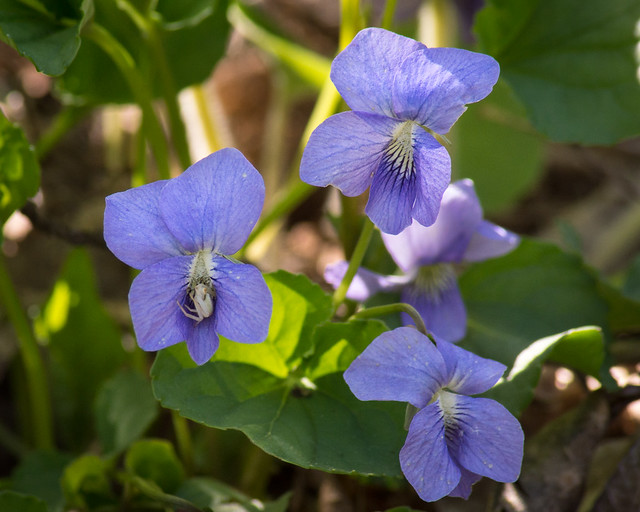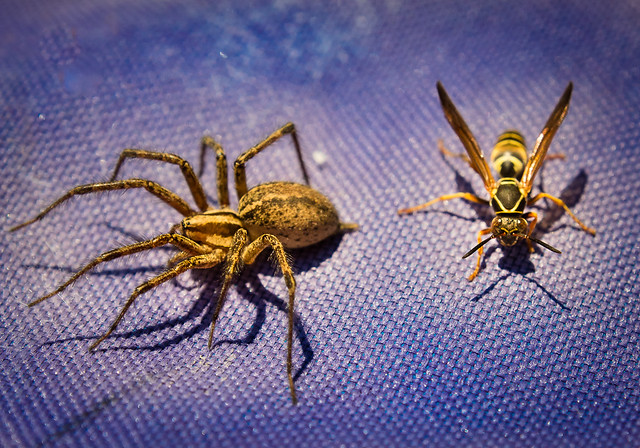Spider
Tiny Surprise

Danger lurks here! When I took this photo on a walk through the woods, I saw only a nice collection of wild violets. It wasn’t until I viewed this image on my computer that I noticed the tiny crab spider hiding in the bloom on the left.
Crab spiders don’t make webs. They hide, often in flowers, waiting for unsuspecting insects to be drawn by the flower’s nectar or pollen.
I’ve posted photos of crab spiders before – even with a short video of one trying grab lunch – that can be viewed HERE.
To view a larger image of this photo, click on it.
Pick Your Poison

On a cool fall day, I uncovered my barbecue grill and found a large spider clinging to the grill cover. The moment I spotted it, I ran into the house…to grab my camera, of course. As I was taking photos of the spider, a wasp buzzed into the shot. (An insect photo bomb!)
I took several shots of the pair before the winged one flew off. While together, they seemed to get along just fine; no signs of tension or animosity.
I’m not sure I’ve ever photographed a more unlikely pair…a more menacing pair…a more dangerous duo.
No insects, arachnids or photographers were injured or harmed in the production of this image.
To get view an even larger version, click on the photo.
A Spider Beside Her
 This is a bit of vintage Pops Digital. This is another image that I found that I haven’t shared on this blog yet.
This is a bit of vintage Pops Digital. This is another image that I found that I haven’t shared on this blog yet.
This is one of those accident shots. I was crouching in the garden, trying to get a good shot of this huge Garden Spider and just as I snapped the image, Sara, my wife stepped into the shot. She didn’t even know I was there.
This photo was selected as Photo of the Day by Earthshots.org
Click on the image to see a larger version.![]()
Guarding the Beauty
 This is kind of a beauty-and-the-beast image. The Dianthus flowers in our yard caught my eye. As I moved in to take the shot, the little crab spider made himself known. I didn’t see him until I was right on top of him. I backed off…then moved in…then backed off…then moved in. When I moved in, he would take an aggressive stance. When I backed off, he would relax. Whatever his strategy was, it must have worked well since, judging by the girth of his tiny frame, I’d say he hadn’t missed any meals.
This is kind of a beauty-and-the-beast image. The Dianthus flowers in our yard caught my eye. As I moved in to take the shot, the little crab spider made himself known. I didn’t see him until I was right on top of him. I backed off…then moved in…then backed off…then moved in. When I moved in, he would take an aggressive stance. When I backed off, he would relax. Whatever his strategy was, it must have worked well since, judging by the girth of his tiny frame, I’d say he hadn’t missed any meals.
This photo was taken several years ago with my old Kodak camera. A little “vintage” Pops Digital for you.
For a closer look, click on the photo.
Found on the Web
 Let me introduce you to a web master. Spider web, that is. This beauty is commonly called a Yellow Garden Spider. The technical name is Argiope Aurantia. They are common in most of North America. We have them in our garden and flower beds each year. This one was photographed while on vacation last summer in Missouri. I saw the spider web and spider with a background of yellow wildflowers and thought it created an interesting visual.
Let me introduce you to a web master. Spider web, that is. This beauty is commonly called a Yellow Garden Spider. The technical name is Argiope Aurantia. They are common in most of North America. We have them in our garden and flower beds each year. This one was photographed while on vacation last summer in Missouri. I saw the spider web and spider with a background of yellow wildflowers and thought it created an interesting visual.
Here are some interesting facts about Argiope Aurantias from the University of Arkansas Anthropod Museum…
Females build large webs, up to two feet in diameter. The female usually eats her web each day and constructs a new one, often in the same place. The web consists of dry spokes supporting a spiral thread of adhesive silk. The hub is separated from the spirals by a free zone. The spiders rest head down day and night at the hub of the web over a conspicuous zigzag band of bright white noncapture silk known as a stabilimentum. The stabilimentum apparently affords protection, perhaps by camouflaging the spiders, startling predators, or acting as an aposematic warning of the presence of webs. It seems to be especially effective in preventing birds from flying through webs.
For another view of the same type of spider, see my earlier post : By A Thread.
If you have a large monitor, clicking on the photo may provide a larger version.
By a Thread
 In the spider world, this is a common character. I’ve found and photographed this type in our gardens in Wisconsin. This one was photographed in the woods of Missouri.
In the spider world, this is a common character. I’ve found and photographed this type in our gardens in Wisconsin. This one was photographed in the woods of Missouri.
We typically refer to this as a Garden Spider. If you want to get technical, it’s a Black and Yellow Argiope (argiope aurantia).
If it won’t creep you out, you can view a larger version of this image by simply clicking on the photo.
The Stand Off

While photographing wildflowers I noticed yellow spiders hiding among the foliage. I believe they are in the crab spider family. They seemed to be waiting for prey to come by. That was, in fact, the case. (See some of my previous posts.)
I’d been photographing these yellow spiders on purple thistles. Then I noticed a similar spider on a yellow flower. While I was taking his picture, a soldier beetle landed on the flower. I wondered what would happen.
After taking a few photos, I decided to switch to taking video. I remembered nature films I’d seen where an alligator snatches an unsuspecting antelope that stopped for a drink. I thought this, on a decidedly smaller scale, might provide the same kind of drama.
I only got a short, six seconds of video. It looked like the solider beetle bumped into the spider and then flew off. Not too dramatic. However, when I slowed the video down, it turns out it was a much closer call than I originally thought.
Watch the video below and pay particular attention to the slow motion footage. When slowed down, you can see the spider actually grabs the leg of the soldier beetle in its jaws. The beetle is able to pull away before the spider can get a better hold. The best way to view it is to click the full-screen icon in the lower right corner of the video box.
Click on the photo at the top to see a lager version.
Fatal Attraction

I discovered yellow spiders hiding among the the thistles. I assumed they were waiting for unsuspecting prey. I took some photos, downloaded them to my computer and posted them to this blog under the title Dangerously Alluring Beauty.
 Several hours later, I went back to check on them. I was right! This is the same thistle and spider from the previous post.
Several hours later, I went back to check on them. I was right! This is the same thistle and spider from the previous post.
As you can see, a small bee, buzzing from flower to flower, attracted by the thistle, received an instant invitation to lunch.
The image on the right is the same scene from a different angle.
I wish I had hung around long enough to catch the action live. However, it just so happens, when I finished photographing this carnage, I noticed a similar yellow spider, poised with arms open wide, waiting for a its meal on a yellow flower. Then a bug came along. I started snapping pictures. The bug walked around the flower until it finally came face to face with the spider…and then…
You’ll have to watch for those images in a future post to see how it turned out.
To view larger versions of either of these photos, just click on them.
Dangerously Alluring Beauty

I went for another walk in the Missouri woods with my camera and noticed something new among the thistles.
 This yellow and black spider was strategically positioned and patiently waiting to strike insects who may be attracted to the colorful thistle.
This yellow and black spider was strategically positioned and patiently waiting to strike insects who may be attracted to the colorful thistle.
If you look closely at the image above, it looks like some of the thistle is twisted in strands to the side – giving the spider easier access to any prey that might land on the top of the flower. Is the spider smart enough to make an easier path to the kill or is it just a naturally occurring coincidence? I wonder.
The photo to the right show another spider snugly tucked deep in the strands of the thistle. Waiting…waiting…waiting…
Now that I look at them, maybe I should have waited to see and document what happens. It might have taken a long time with me just a few inches from the blossoms. The spiders are more patient than I am.
You can get a closer look at either photo by simply clicking on them.
Spider in the Sky
 The first thing that popped into my mind when I saw this image was, “That looks like a green spider on its web!” This might be my favorite photo of Algoma’s Shanty Days fireworks show.
The first thing that popped into my mind when I saw this image was, “That looks like a green spider on its web!” This might be my favorite photo of Algoma’s Shanty Days fireworks show.
As long as I’m using a bit of imagination, the two white star bursts remind me of flies caught in the web.
Of course, I didn’t and couldn’t have planed it. I just accidentally captured it. Right place + fluke timing = pleasant surprise!
Well…am I right? Do you think it looks like a spider and web? Is this cool or what?
Bonus Photo: another multiple burst, Shanty Days fireworks image.
 If you find these images interesting, please share this post with your friends. I’d like to increase the number of regular visitors to PopsDigital.com.
If you find these images interesting, please share this post with your friends. I’d like to increase the number of regular visitors to PopsDigital.com.
(If you have a large monitor, you may be able to see larger versions of these photos by clicking on them.)


















































